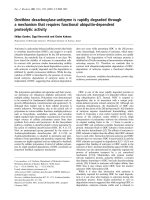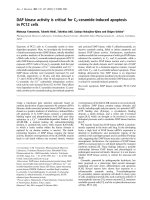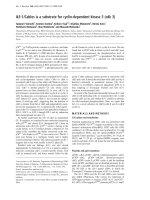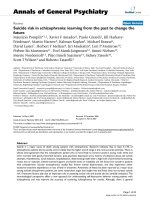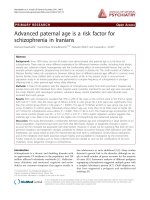Báo cáo y học: "Critical illness hyperglycemia: is failure of the beta-cell to meet extreme insulin demand indicative of dysfunctio" pot
Bạn đang xem bản rút gọn của tài liệu. Xem và tải ngay bản đầy đủ của tài liệu tại đây (206.55 KB, 2 trang )
Available online />Page 1 of 2
(page number not for citation purposes)
Abstract
In the recent study by Preissig and Rigby in Critical Care, the
authors argue that critical illness hyperglycemia in children with
both respiratory failure and cardiovascular failure is due to a
primary failure of the beta-cell. However, alternative explanations
that the failure is secondary to an increase in insulin resistance
leading to beta-cell exhaustion, or a negative impact of exogenous
glucocorticoid therapy, may be equally likely.
In their study on hyperglycemia in critically ill children Preissig
and Rigby [1] observed that children in the pediatric intensive
care unit are unlikely to have critical illness hyperglycemia
(CIH) in the absence of respiratory failure (RF) or cardio-
vascular failure (CVF) (0 of 12 patients studied), whereas
those with RF but without CVF may (9 of 18) or may not (9 of
18), and virtually all patients with both RF and CVF do (10 of
11). The key observation was that the C-peptide level in
children without CIH was similar for those with RF versus
those without RF or CVF (2.3 versus 5.3 ng/ml), whereas in
children with CIH, C-peptide was significantly higher with RF
alone than with RF and CVF (11.5 versus 4.4 ng/ml; data
reproduced in Figure 1). Importantly, the RF and CVF cohort
uniformly received exogenous glucocorticoid therapy, unlike
the other cohorts (100% versus 44% to 50%). The authors
concluded from their data that elevated insulin resistance
(high C-peptide) was the prominent cause of CIH in children
with RF only, whereas beta-cell dysfunction (low C-peptide)
was the primary cause in children with RF and CVF.
We find the results very interesting but would take care in
concluding that CIH in children with both RF and CVF is due
primarily to a failure of the beta-cell. The beta-cell has a very
complex response to hyperglycemia both acutely (first and
second phase responses over just minutes [2,3]) and over
the course of several days (increased mass [4,5]). Also, beta-
cell exhaustion is a well known phenomenon characterized by
an ability to increase secretion up to a certain level and
thereafter fail in response to further demand [6,7]. Finally,
exogenous glucocorticoid therapy, given to all patients with
RF and CVF together, can also have complex interactions
with insulin secretion, suppressing it in some in vitro studies
[8,9] and enhancing it in other in vivo studies [10,11].
Support for these mechanisms playing a major role in CIH is
variable, but there is insufficient evidence to dismiss the
mechanisms.
Arguments that the beta-cell can rapidly adapt, or become
exhausted, when faced with increased demand provide an
alternative hypothesis to that put forth by Preissig and Rigby.
With adaptation, the difference in C-peptide levels observed
in the RF group without CIH compared to the group that had
neither RF nor CVF (5.3 versus 2.3 ng/ml) could indicate
beta-cell adaptation, with the twofold increase in secretion
having failed to achieve statistical significance due to the
small number of subjects in each group (9 and 12 subjects,
respectively). That the two groups had similar glucose levels
(5.8 versus 6.1 mmol/l) with different secretion (C-peptide)
could occur if the beta-cells’ second phase response is
interpreted as increasing insulin secretion when glucose is
above a threshold [12]. The remaining 9 out of 18 patients
with RF and no CVF may have had CIH only because the
beta-cell did not have sufficient time to normalize the level.
That is, in the study CIH was defined as two blood glucose
values taken 1 to 2 hours apart both above 7.7 mmol/l. This
definition does not preclude the possibility that glucose was
decreasing at the time CIH was assessed. The unarguable
failure of the beta-cell to normalize glucose in children with
RF+CVF could be attributed to beta-cell exhaustion (low
C-peptide levels) secondary to further increases in insulin
resistance in this group. By the authors’ own estimates, the
Commentary
Critical illness hyperglycemia: is failure of the beta-cell to meet
extreme insulin demand indicative of dysfunction?
Garry M Steil and Michael SD Agus
Children’s Hospital Boston, 300 Longwood Avenue, Boston, MA 02115, USA
Corresponding author: Michael SD Angus,
Published: 3 April 2009 Critical Care 2009, 13:129 (doi:10.1186/cc7756)
This article is online at />© 2009 BioMed Central Ltd
See related research by Preissig and Rigby, />CIH = critical illness hyperglycemia; CVF = cardiovascular failure; RF = respiratory failure.
Critical Care Vol 13 No 2 Steil and Agus
Page 2 of 2
(page number not for citation purposes)
RF+CVF subjects required longer, and at times up to 50%
more, exogenous insulin to normalize glucose. Using the
values reported, one could argue that the beta-cell had
sufficient capacity to meet a peak demand of 0.13 U/kg/h for
5.8 days (RF group) but an insufficient capacity to meet a
peak demand of 0.19 U/kg/h for 8.7 days (RF+CVF group).
The clinical entity of RF+CVF represents a temporal and
clinical progression from the state where only one is present -
the key question during this progression being what changes
are occurring in peripheral insulin sensitivity and beta-cell
function. In the authors’ data, the issue becomes whether the
low C-peptide levels in the RF+CVF group are indicative of a
lower level of insulin resistance (Preissig and Rigby’s argu-
ment), or whether the higher exogenous insulin required to
bring these patients to target is indicative of higher resis-
tance. Discerning whether beta-cell exhaustion, or events
secondary to the glucocorticoid therapy, contributed to the
low insulin secretion will be essential in guiding future treat-
ment strategies.
Competing interests
The authors declare that they have no competing interests.
Acknowledgements
MSDA is presently conducting an on-going trial of tight glycemic
control following cardiac surgery in a cohort of children less than 3
years old (US National Institutes of Health R01HL088448).
References
1. Preissig CM, Rigby MR: Hyperglycaemia results from beta-cell
dysfunction in critically ill children with respiratory and cardio-
vascular failure: a prospective observational study. Crit Care
2009, 13:R27.
2. Elahi D: In praise of the hyperglycemic clamp. A method for
assessment of B-cell sensitivity and insulin resistance. Dia-
betes Care 1996, 19:278-286.
3. Toschi E, Camastra S, Sironi AM, Masoni A, Gastaldelli A, Mari A,
Ferrannini E, Natali A: Effect of acute hyperglycemia on insulin
secretion in humans. Diabetes 2002, 51(Suppl 1):S130-S133.
4. Jonas JC, Laybutt DR, Steil GM, Trivedi N, Pertusa JG, Van de
Casteele M, Weir GC, Henquin JC: High glucose stimulates
early response gene c-Myc expression in rat pancreatic beta
cells. J Biol Chem 2001, 276:35375-35381.
5. Steil GM, Trivedi N, Jonas JC, Hasenkamp WM, Sharma A,
Bonner-Weir S, Weir GC: Adaptation of beta-cell mass to sub-
strate oversupply: enhanced function with normal gene
expression. Am J Physiol 2001, 280:E788-E796.
6. Grill V, Bjorklund A: Impact of metabolic abnormalities for beta
cell function: clinical significance and underlying mechanisms.
Mol Cell Endocrinol 2009, 297:86-92.
7. Steil GM, Doria A, Soeldner JS, Warram JH: Heterogeneity of B-
cell compensation during progression to NIDDM. Diabetes
1997, 46(Suppl 1):0944.
8. Barseghian G, Levine R, Epps P: Direct effect of cortisol and
cortisone on insulin and glucagon secretion. Endocrinology
1982, 111:1648-1651.
9. Lambillotte C, Gilon P, Henquin JC: Direct glucocorticoid inhibi-
tion of insulin secretion. An in vitro study of dexamethasone
effects in mouse islets. J Clin Invest 1997, 99:414-423.
10. Ludvik B, Clodi M, Kautzky-Willer A, Capek M, Hartter E, Pacini G,
Prager R: Effect of dexamethasone on insulin sensitivity, islet
amyloid polypeptide and insulin secretion in humans. Dia-
betologia 1993, 36:84-87.
11. Hollingdal M, Juhl CB, Dall R, Sturis J, Veldhuis JD, Schmitz O,
Pørksen N: Glucocorticoid induced insulin resistance impairs
basal but not glucose entrained high-frequency insulin pul-
satility in humans. Diabetologia 2002, 45:49-55.
12. Steil GM, Clark B, Kanderian S, Rebrin K: Modeling insulin
action for development of a closed-loop artificial pancreas.
Diabetes Technol Ther 2005, 7:94-108.
Figure 1
Blood glucose (BG) and C-peptide (CPEP) levels in children with (+) or
without (-) critical illness hyperglycemia (CIH), with or without respiratory
failure (RF) or cardiovascular failure (CVF). Data taken from [1].
